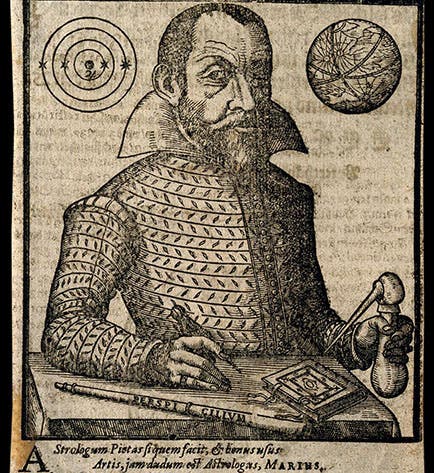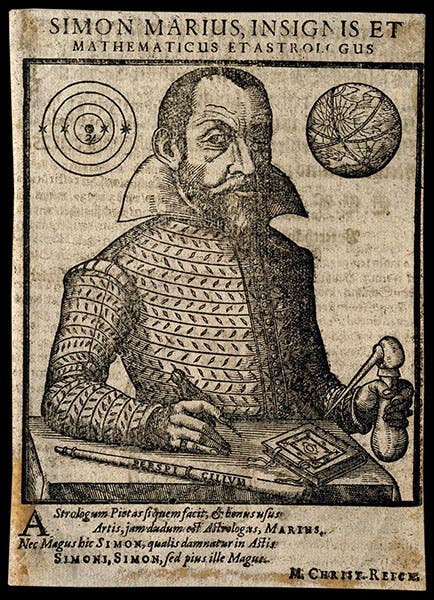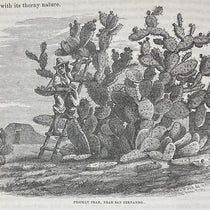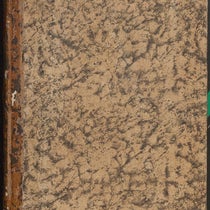Scientist of the Day - Simon Marius
Simon Marius, a German astronomer, was born Jan. 20, 1573. Marius was born in Gunzenhausen, and died in Anspach, neither town very far from Nuremberg, so he was Bavarian through and through. In 1614, Marius created quite a sensation with the publication of his book, Mundius jovialis, a book we do not, alas, have in our collections. Galileo had discovered that Jupiter has four moons or satellites, his initial observation coming on Jan. 7, 1610, and he announced the discovery right on the title page of his Sidereus nuncius, published just two months later in March 1610. In his book, published 4 years later, Marius announced that he had first seen three of Jupiter's moons through his own telescope on Dec. 29 of 1609. Marius knew that Dec. 29 in his Julian calendar was equivalent to Jan. 8, 1610, of Galileo's Gregorian calendar, which would make his initial observation one day later than Galileo's, but it sounded as if he were saying he saw them first. Marius had printed a diagram of Jupiter’s moons earlier, in an almanac for 1612, but did not there claim he had discovered the moons himself.
Galileo was not pleased with what seemed to be an attempt to usurp his priority, and he retaliated in his Il Saggiatore (The Assayer, 1623), where he called Marius a plagiarist, who had attempted to steal Galileo's discoveries and claim them as his own. Debate on the validity of Marius' claim has continued to the present day, and Marius now has many fans, mostly Bavarians who think Galileo’s achievements are overblown; in 2014, on the 400th anniversary of the publication of Marius’s book, the Nuremberg Astronomical Society convened an international conference to promote their native son, and to establish a website – the Marius Portal as they call it – to further advance the Marius cause. The conference proceedings have been published in both German and English – we have both versions in our collections (here is a link to the English edition). With few exceptions, most of the contributors to the proceedings defend Marius as a co-discoverer of the moons of Jupiter, as does the Portal.
Does Marius deserve credit for the independent discovery of Jupiter's moons? It is really hard to say. There is good evidence that Marius observed Jupiter's moons for years, and in some instances did a better job than Galileo. But there is no evidence other than his word that Marius discovered the moons independently, about the same time as Galileo. And the claim came four years after the supposed fact. One can understand why Galileo was incensed. His outrage is often labelled "unjustified" by Marius defenders, but it seems justified enough, given the circumstances and the lack of corroboration for Marius’s claim. And nothing is really different today – there has been no new evidence uncovered, so it is still a matter of choice – believe Marius, or don't believe him. Some seem to think that the fact that Marius had a telescope by the beginning of the year 1610 is evidence enough – all he had to do was look in the direction of Jupiter, and voilà – four moons. But as Albert Van Helden, an expert on the early history of the telescope, has pointed out, the telescopes of 1610 were very crude – you could hardly find the Moon in them – and it was six months before anyone in Italy could confirm Galileo's discovery of Jupiter's moons. The fact that Marius had a telescope does nothing to make his claim more likely.
The odd thing about the contretemps is that there are plenty of other reasons for praising Marius. Once he had a good telescope, he did some surprising things with it. In 1612, he observed a fuzzy patch, a nebula, in Andromeda. This was the first observation in the West of this famous celestial object, which is about four times bigger than the Moon but so diffuse that it is almost impossible to make out with the naked eye or a small telescope – unless someone tells you it is there. We now know that the Andromeda nebula had actually been seen more than 650 years earlier, by the Islamic astronomer al-Sufi, who glimpsed it without a telescope and recorded it in his Book of the Fixed Stars, 964 C.E, and there are many pre-Galilean manuscripts of the Book of Fixed Stars that unmistakably record the nebula on the star chart of Andromeda, just in front of the nose of the intruding fish of Pisces. Al-Sufi's priority wouldn’t be asserted until 1667, when the French astronomer Ismael Boulliau published the al-Sufi drawing of Andromeda in his pamphlet on Andromeda, so it is evident that Marius made his discovery on his own. His description (without image) is in the Mundus jovialis.
Marius was also the first to use the telescopic appearance of stars as a factor in choosing a cosmology. Stars viewed through a telescope have a definite size. We now know that the apparent size is spurious – an optical effect – but no one knew that in 1614. If stars have a measurable size, and they exhibit no parallax, which they should if the Earth is in orbit around the Sun, then they must be very far away and absolutely enormous, far larger than the Sun. The only way to avoid this conclusion is to keep the Earth at rest, and that is what Marius did – he opted for the Tychonic system of Tycho Brahe, where everything BUT the Earth orbits the Sun, and the Sun then circles the Earth. He did so because he accepted an observed fact that Copernicans had to ignore if they were to accept the Earth’s motion. That was a commendable choice by Marius, under the circumstances.
Another thing that Marius definitely did do, which Galileo did not, was to suggest names for the new moons of Jupiter. In his Mundus, after mulling over some possible names passed on to him by Kepler, Marius suggested calling the moons: Io, Europa, Ganymede, and Callisto, after four of Jupiter’s lovers from Greek mythology. No one paid much attention to these names for practically 300 years – astronomers, those incorrigible romantics, preferred to call them I, II, III, and IV. But now that these moons have distinct personalities and faces, thanks to the Voyager spacecraft and the Hubble Space Telescope, the names offered by Marius are in regular use. He (and Kepler) deserve credit for that.
We have not yet mentioned the portrait of Marius, which appeared as a frontispiece to the Mundus jovialis (here is the frontispiece in Harvard’s Houghton Library’s copy of the Mundus), and was also printed separately, with a different caption, as a copy in the Wellcome Collection attests (first image). It is noteworthy for containing the first printed image of a telescope, and for showing Jupiter’s moons in orbit around the planet, a diagram that Galileo never included in his book. A version of the diagram had appeared earlier, in Marius’s Prognostication of 1612, which is a very scarce bit of ephemera, two copies being known. You can see the 1612 diagram on the home page of the Marius portal. We might add that the second printed image of a telescope appeared in Johann Georgius Locher’s Disquisitiones mathematicae (1614), a book we do have in our collections (although catalogued under Christoph Scheiner, Locher’s thesis director). It came out the same year as Marius’s book, but since Locher discussed Marius (unfavorably), we know Marius’s book was printed first. We show Locher’s woodcut here (second image), since I don’t think the two images have ever appeared on the same page before.
There is a monument to Marius in Ansbach, where he worked and died, put in place in 1991. It consists of a horizontal circular design in bronze and stone, depicting the Jovian moon system, with each of the four moons labeled with the names invented by Marius. Alongside, there is a strangely-shaped head, supposedly that of Marius, lying on the ground, unencumbered by a body, observing, one supposes, the heavens, but without his telescope. The telescope is across the way, lying in the gutter of an opened bronze book, on which is written, in German, words to the effect that Marius of Ansbach discovered the four Jovian moons in 1609 and wrote his book in 1614. Clearly fans of Galileo should tour elsewhere. There are five fine photos of the various elements of the Marius memorial at this website, maintained by René and Peter van der Krogt.
William B. Ashworth, Jr., Consultant for the History of Science, Linda Hall Library and Associate Professor emeritus, Department of History, University of Missouri-Kansas City. Comments or corrections are welcome; please direct to ashworthw@umkc.edu.








